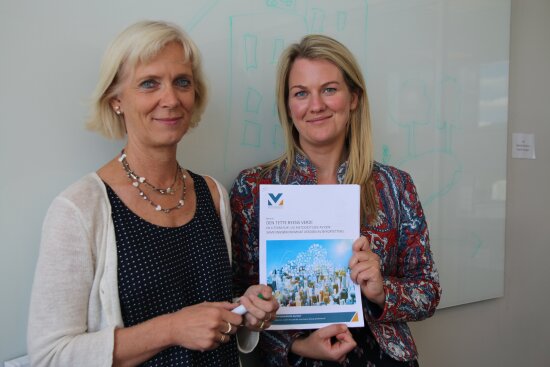But that is not entirely true. Concentrated cities can result in fewer greenhouse gas emissions, more business development and happier people in parks and cafés. But what does that mean exactly and is that the whole truth?
Menon Economics prepared the report ‘Den tette byens verdi’ (The Value of the Concentrated City) on behalf of Design and Architecture Norway (DOGA). The report aimed to increase knowledge about urban concentration and its consequences, as well as to provide city planners, architects and others with a better decision-making basis when building the cities of the future.
“Urban development that entails concentrated cities has been considered solely positive for a long time. The positive aspects of urban concentration have been the focus and a number of conditions have been assumed. But there have been few integral, socioeconomic analyses of the consequences of concentrated cities in Norway,” says Kristin Magnussen, one of four socioeconomists who has investigated the availability of literature and methods regarding this theme, both in Norway and internationally.
“We were under the assumption that more research had been conducted in Norway and the Nordic countries than was actually the case. Few have examined urban concentration and its consequences as a whole, examining primarily the various aspects separately. These are themes that are of interest to many, but that have been researched relatively little,” says Caroline Wang Gierløff.
Gierløff and Magnussen believe that more research and analyses are needed to determine for certain what constitutes good socioeconomic solutions when concentrating our cities. Otherwise, planning work can be based too much on assumptions and not result in the best solutions for society.
Critical pain point
In examining research results, which were primarily from Norway and the Nordic countries though also from other regions of the world, they did, however, find that urban concentration generally contributes positively in the form of less private transport and more public transport options. This has positive effects in the form of reduced emissions of greenhouse gases, reduced local pollution and better public health. But, for example, if the public transport options are not expanded in line with increased urban concentration, this can lead to increased local pollution.
In studying the available literature, Menon also found that urban concentration can contribute to economies of scale and quality improvements in both private and public services, as well as strengthen urban qualities and the corresponding values. It has also become clear that there is a higher level of productivity and value creation in concentrated urban areas.
“Concentration, i.e. that more people use services or goods, can increase value. A green area in a city can become more valuable when more people use it and derive pleasure from it. A park that almost no one uses has lower socioeconomic value,” says Gierløff.
At the same time, the research points out a pain point: If there are too many people in the park and the cafés are packed without the possibility to find a table, the value for that specific park or café-goer is reduced.
Possibility of increase in crime and poorer public transport
The report shows that homes located near parks, green areas, cultural monuments and public transport have a relatively higher value than similar homes located further away from green areas or that are exposed to more traffic noise. The negative consequences of urban concentration include greater differences due to higher home prices in the most attractive areas, an increase in crime and more pressure on public transport and social programmes and services.
“I think we need to be honest and consider the negative and positive consequences within the larger context and analyse these further for purposes of method development and more empirical results, as well as compare and actively incorporate the effects into planning work,” says Gierløff.
“It is not a given that what is profitable in terms of business management or acceptable in terms of planning is also beneficial for society,” points out Magnussen.

Photo: Elsebeth Danielsen
Gierløff and Magnussen emphasise the importance of more research, so that we can avoid urban concentration with negative effects.
“There is no method currently available that exposes the consequences of urban concentration in a manner that is comparable to other societal measures. This means that measures are treated differently in planning work, guidelines and decisions,” adds Magnussen.
That is why she believes it is very positive that DOGA is focusing on this field and attempting to get a better sense of the situation.
“It is a good idea to start with an overview of the available knowledge about the socioeconomic effects of urban development and concentration. This also yields possibilities to develop the field further, such as by examining what is done in other countries and sectors that have developed methods and unit prices to a greater extent and that can be used in assessing measures,” she adds.
Urban concentration debate important
Siri Holmboe Høibo, Architectural Consultant at DOGA, explains that the goal of the Menon study has been to obtain an overview of existing studies and information on urban concentration.
“We are now interested in obtaining feedback, connecting with interested parties and collaborative partners and generating a discussion on the value of the city. Together we can examine how architects, consultants, developers, municipalities and politicians can use this knowledge to make better decisions during the future development of our cities,” she says.


